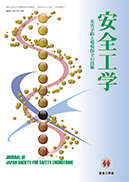
- Issue 6 Pages 01-
- Issue 5 Pages 01-
- Issue 4 Pages 01-
- Issue 3 Pages 01-
- Issue 2 Pages 01-
- Issue 1 Pages 01-
- |<
- <
- 1
- >
- >|
-
2024Volume 63Issue 1 Pages 01-02
Published: February 15, 2024
Released on J-STAGE: February 16, 2024
JOURNAL RESTRICTED ACCESSDownload PDF (544K)
-
Hiroyoshi Naito2024Volume 63Issue 1 Pages 1
Published: February 15, 2024
Released on J-STAGE: February 16, 2024
JOURNAL RESTRICTED ACCESSDownload PDF (568K)
-
Masao MukaidonoArticle type: review-article
2024Volume 63Issue 1 Pages 2-8
Published: February 15, 2024
Released on J-STAGE: February 16, 2024
JOURNAL RESTRICTED ACCESS -
Yuichi FushiwakiArticle type: review-article
2024Volume 63Issue 1 Pages 9-16
Published: February 15, 2024
Released on J-STAGE: February 16, 2024
JOURNAL RESTRICTED ACCESS -
Shuichi MunakataArticle type: review-article
2024Volume 63Issue 1 Pages 17-24
Published: February 15, 2024
Released on J-STAGE: February 16, 2024
JOURNAL RESTRICTED ACCESS
-
Nicharee Thinnakornsutibutr, Kazunori Kuwana, Masayuki Mizuno, Takeo U ...2024Volume 63Issue 1 Pages 25-30
Published: February 15, 2024
Released on J-STAGE: February 16, 2024
JOURNAL FREE ACCESSThis study proposes an early-warning method through noise characterization for anomaly forecast of the thermal runaway of exothermic reactions. A one-equation model based on the classical Semenov theory is considered to demonstrate the capability of the proposed method. The model has a parameter, δ, that characterizes the heat-generation rate relative to the heat-loss rate. A steady state can be achieved only when the δ is less than or equal to its critical value. We extended the criticality concept for a more realistic system with random noises. A stochastic differential equation (SDE) is numerically solved using the Euler-Maruyama method. The results show a slower recovery rate from a perturbed state near the critical condition. Because of the slowness, the standard deviation and the autocorrelation increase before the occurrence of thermal runaway. A dynamical marker that enables early detection is proposed and tested against a specific example of temperature evolution in a chemical process. It was found that the dynamical marker increased significantly more rapidly than other values, such as the smoothed temperature, the standard deviation, and the autocorrelation, showing that the dynamical marker is a promising safety index for early detection.
View full abstractDownload PDF (5626K) -
[in Japanese], [in Japanese], [in Japanese], [in Japanese], [in Japane ...2024Volume 63Issue 1 Pages 31-38
Published: February 15, 2024
Released on J-STAGE: February 16, 2024
JOURNAL FREE ACCESSWhen a large customer starts or stops using city gas, flow and pressure fluctuations occur in surrounding pipeline .From the perspective of maintaining a stable supply and preventing accidents, it is important to evaluate whether the pressure exceeds the maximum design pressure of the pipe or falls below the minimum pressure required for supply .In this study, we first measured the pressure response in an air experiment .The reproducibility of experimental values was confirmed by numerical simulation [1] .Next, parameter studies were conducted for city gas operating conditions (pipe length, supply pressure, and consumption flow rate), and it was shown that the pressure fluctuation values are correlated with pipe friction, inertia, flow velocity, kinetic energy, and pipe length .Within the scope of this study, the maximum pressure fluctuation was at most 30 % and the minimum pressure fluctuation was at most 10 % for all operational conditions.
View full abstractDownload PDF (10667K)
-
Haruhiko Itagaki2024Volume 63Issue 1 Pages 39-43
Published: February 15, 2024
Released on J-STAGE: February 16, 2024
JOURNAL RESTRICTED ACCESS
-
Kenichiro Okuma, Junichi Hino, Jiro Hamada2024Volume 63Issue 1 Pages 44-47
Published: February 15, 2024
Released on J-STAGE: February 16, 2024
JOURNAL RESTRICTED ACCESSDownload PDF (2899K) -
Fukutaro Noguchi, Kazuhiro Takahashi2024Volume 63Issue 1 Pages 48-52
Published: February 15, 2024
Released on J-STAGE: February 16, 2024
JOURNAL RESTRICTED ACCESSDownload PDF (2355K)
-
Wookyung Kim2024Volume 63Issue 1 Pages 53-56
Published: February 15, 2024
Released on J-STAGE: February 16, 2024
JOURNAL RESTRICTED ACCESSDownload PDF (4160K)
-
[in Japanese], [in Japanese], [in Japanese], [in Japanese]2024Volume 63Issue 1 Pages 57-63
Published: February 15, 2024
Released on J-STAGE: February 16, 2024
JOURNAL RESTRICTED ACCESSDownload PDF (793K)
-
2024Volume 63Issue 1 Pages 64
Published: February 15, 2024
Released on J-STAGE: February 16, 2024
JOURNAL RESTRICTED ACCESSDownload PDF (473K)
- |<
- <
- 1
- >
- >|